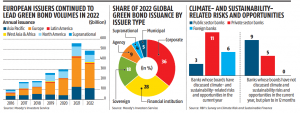The details of the transition towards climate-change-related finance will require deft handling handling, reports Raghu Mohan
In the first fortnight of January, the Export-Import Bank of India raised $1 billion in green bonds priced at 190 basis points over the 10-year US Treasury Bill. The deal — put through by J P Morgan, Bank of America (BankAm), Barclays, Citigroup, HSBC, Mitsubishi UFJ Financial Group, and Standard Chartered Bank — was the largest such issuance by an Indian entity.
Close on its heels came the maiden auction of twin sovereign green bonds for a cumulative Rs 8,000 crore, via five- and 10-year papers. And last week saw a Rs 244-crore float in the same genre by the Indore Municipal Corporation being oversubscribed 5.91 times and listed on the National Stock Exchange.
The buzz in bank corner rooms is that the Reserve Bank of India (RBI) is set to nudge regulated entities to earmark a portion of their incremental book for green projects; and that this may be part of a transition road map that is in the works. Rajeshwar Rao, deputy governor, RBI, said recently that green finance must be scaled up rapidly to meet climate targets under the updated Nationally Determined Contribution communicated to the United Nations Framework Convention on Climate Change in August 2022.
Speaking at Business Standard BFSI Insight Summit last December, he observed that “green infrastructure investment trusts could help scale up green finance and also deepen the local bond market.” The grapevine has it that these aspects may get fleshed out when Mint Road rolls out its taxonomy for green financing, building on the ‘Sovereign Green Bonds’ framework and the Securities and Exchange Board of India’s reporting architecture on sustainable finance.
Understandably, global capital is willing to step in big-time.
“It’s no longer a push or a pull initiative among stakeholders, but a wholesome approach whereby each stakeholder appreciates the importance of combating climate change and undertaking necessary actions to implement an effective ESG (environmental, social, and corporate governance) framework and strategy,” says Kaustubh Kulkarni, senior country officer, India, and vice-chair (Asia Pacific), JPMorgan.
Its strategy is aligned to the Paris Agreement of 2015 to hold “the increase in the global average temperature to well below 2*C above preindustrial levels and limit the temperature increase to 1.5*C above pre-industrial levels.” In 2020, JPMorgan put in place a $2.5-trillion, 10- year sustainable development financing target.
The upbeat mood is shared by Raj Balakrishnan, co-head (India Investment Banking) at BankAm. “We are bestowed with attractive solar and wind resources and can become a major manufacturing hub supporting clean-energy installations globally, and present a great alternative to China,” says Balakrishnan. “Indian players have successfully tapped the ESG-themed global pool of debt and equity and there’s significant confidence among foreign investors in our macro and sector outlook.”
BankAm has committed $1.5 trillion to sustainable business, even as it has cornered a 70 per cent share in local renewable mergers and acquisitions, helping clients raise over $5 billion in equity and $3 billion in debt.
Nuts and bolts
Back in 2006, PwC had argued in its report, The World in 2050, that rapid economic growth in China and India (and more moderate growth in the advanced economies) could have serious long-term consequences for global energy consumption and carbon emissions. As emerging ‘E7’ economies (China, India, Brazil, Russia, Indonesia, Mexico and Turkey) increase in size to overtake the G7 countries, they would account for almost half of global carbon emissions by 2050.
Just how are local lenders placed on the green road?
Mint Road issued its first notification on what is now referred to as sustainable finance as far back as December 2007. It observed that banking and finance’s immediate environmental and social impacts are relatively indirect because these are delivered through the activities of other businesses that rely on financial institutions. Nevertheless, “despite the relatively indirect nature of their environmental and social impacts, banks need to examine the effects of their lending and investment decisions”.
Banks were to put in place an appropriate plan of action to further the cause of sustainable development with the approval of their boards, keeping in view the Equator Principles, which provide a due diligence framework for banks to manage the social and environmental risk of financing large projects. Signed off by the late Vijaya Bhaskar, then the RBI’s chief general manager, it was a 26-page guidance note on climate- related financing — perhaps the first by any central bank in the world.
Yet, over a decade later, the RBI’s Survey on Climate Risk and Sustainable Finance (July 2022) noted that board-level engagement on climate risk and sustainable finance is inadequate. In about a third of the banks surveyed, “responsibility for overseeing initiatives related to climate risk and sustainability was yet to be assigned”; and only a few banks had included climate risk and ESG-related “key performance indicators in the performance evaluation of their top management.” Four out of a dozen state-run and seven out of 16 private banks had yet to consider it a material threat to their business.
Some have taken the lead to address these issues.
Axis Bank has a board-approved ‘ESG Policy for Lending’. It also has a larger initiative for managing climate risk at the enterprise level, overseen by the chief risk officer at the portfolio level. “We have committed to incremental lending of Rs 30,000 crore by 2026 to eligible project categories under the corporate banking book,” says Rajiv Anand, the bank’s deputy managing director.
In 2016, Axis Bank issued the first certified green bond by an Indian bank, for $500 million; and a smaller $40-million bond in 2019 on a private placement basis. In 2021, it floated the first sustainable AT1 bond for $600 million; close to 50 per cent was subscribed to by sustainability- focused investors. “We have entered into blended finance deals with credible market players to drive forward investments into sectors with a positive climate or social impact, where the inherent risk is shared by the deal participants,” adds Anand.
Another fraught issue is the silos to be navigated, which can trip the plot. “Incentives for private participation, constant review of policies by market regulators, and ensuring that the supply chain is monitored so that the green initiative is not restricted to large players,” will be key, says Rajesh Narain Gupta, managing partner, SNG & Partners.
Getting talent at the board level can prove tricky. The Banking Regulation Act (1949) says not less than 50 per cent of the directors are to be drawn from specific professional pools. Intense scrutiny of independent directors plus the far lower levels of compensation payable to them (compared with the wider corporate world) has made hiring good hands tougher. Then again, independent directors of a company cannot be on the board of any bank that lends to that company, which reduces the supply of qualified candidates.
But Amit Tandon, founder and managing director, Institutional Investor Advisory Services (the largest proxy advisory firm in India), points out: “It’s not necessary that you have a green expert on a lender’s board. You can always get a consultant to brief the board. As long as the board is aware of the issues involved, that is what matters”.
Is a dedicated arm the best approach to tackling green finance, especially given the skillsets needed? Take Tata Cleantech Capital (TCCL), a subsidiary of Tata Capital (classified as an infrastructure finance company). It’s a joint venture between Tata Capital and the International Finance Corporation. “We have hired not just from financial services, but also from the cleantech industry, to build a dedicated research team for carrying out proactive studies and developing expertise in each emerging sector,” says Manish Chourasia, managing director, TCCL.
The approach has paid dividends — it financed over 2.5 Gw and 20 ESCOs (energy service companies), 240 e-buses, 187 minimal liquid discharge (MLD) in sewage water treatment and 12.5 MLD in the water desalination segment in FY22. It is among the first lenders to sanction a loan for a green hydrogen project, having inked a 10-billion-yen loan deal with Japan International Cooperation Agency (co-financed with the Sumitomo Mitsui Banking Corporation) for renewable energy generation, e-mobility solutions, and energy efficiency.
As India Inc draws up its expansion plans, the details involved in the green finance journey will have to be crafted well. “The transition phase has to recognise that we can’t switch from a carbon-filled to a net-zero world at the flick of a switch. Modern society and prosperity uses a lot of resources, and moving too fast would jeopardise the widespread political and popular support needed to bring about lasting change,” explains Narendra Murkumbi, vice-chairman, Ravindra Energy.
The green road cannot be full of potholes.
“It’s no longer push or pull, but an approach where each stakeholder appreciates the importance of combating climate change” KAUSTUBH KULKARNI Senior Country Officer (India) & Vice-Chair (Asia Pacific), JPMorgan.
“We have committed to incremental lending of Rs 30,000 crore by 2026 to eligible project categories under the corporate banking book” RAJIV ANAND Deputy Managing Director, Axis Bank.
“We can become a major manufacturing hub supporting clean-energy installations globally, and present an alternative to China” RAJ BALAKRISHNAN Co-Head (India Investment Banking), BankAm.
“It’s not necessary to have a green expert on a lender’s board. You can get a consultant to brief it. It should be aware of the issues involved” AMIT TANDON Founder & Managing Director, Institutional Investor Advisory Services.
“We cannot reach a net-zero world at the flick of a switch. You need political and popular support for bringing about lasting change” NARENDRA MURKUMBI Vice-Chairman, Ravindra Energy.
“We have hired from the clean-tech industry to build a dedicated research team and develop expertise in each emerging sector” MANISH CHOURASIA Managing Director, Tata Cleantech Capital.




